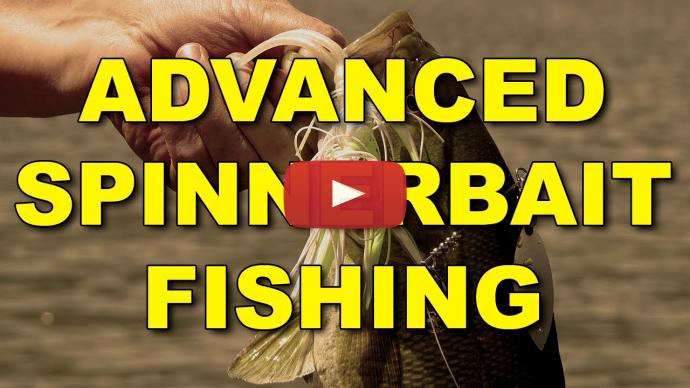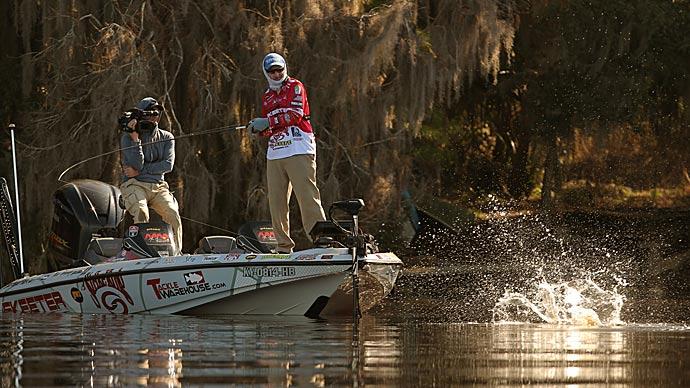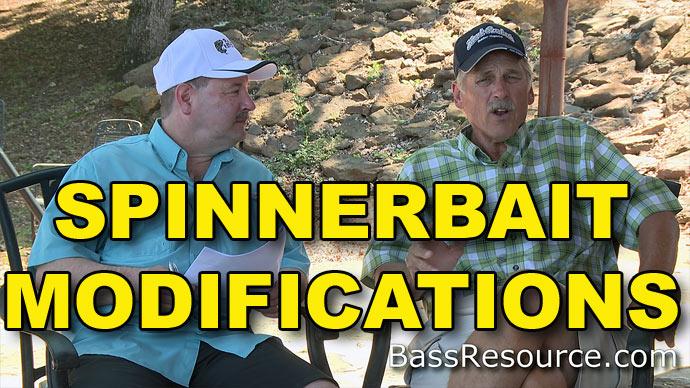Glenn: There we go. It's a good fish. Yeah, he's not gonna do anything, come here. Yeah, he just came right up and smacked it. Nice little belly on him.
Keri: Yeah, he's eating, getting ready to spawn.
Glenn: Hey folks, Glenn May here with BassResource.com. And today, I wanna talk about fishing spinnerbaits in the spring, and how to catch a lot more fish with them. You know, it's funny, I get a lot of e-mails, I get a lot of...I see a lot of questions on our forums, and I see a lot of people mention that they don't have a lot of confidence in spinnerbaits. And it's hard for me sometimes to comprehend because a spinnerbait is one of my top confidence baits. I've been fishing them for decades, and I've caught countless fish on them in all kinds of conditions all season long. So, let me talk to you a little bit about kind of what it is about spinnerbaits, and how to get more confidence in them.
The first thing I'm gonna tell you is a spinnerbait doesn't resemble anything in nature. And I think that's maybe the key thing why people have a hard time having confidence in them, because it doesn't look like a worm, or a jig, or, you know, the crawfish, or a baitfish. It's hard to think that a bass would hit it, but let's think of it this way, let's think of an analogy here.
Cats and string. Cats by nature don't eat string, it's not something that you see out in the wild that they go out attack. Maybe it kind of looks kind of like a snake, but I've never seen a snake that looks this thin, unless it's a baby. But what happens is, you throw a string past a cat, cat's here, and you move that string, he may notice the string moved, you know, kind of, "Whoa, you know, look at that." But he won't really attack it, most of them. Unless it’s a kitten, they attack anything just like little baby bass attack giant lures. But it moves just a little bit and it gets their attention. What happens is when you get towards the end part, that's where it really gets their attention. They can focus on it. It looks like it's moving a little bit more than the rest of the string, but that's when they attack. When it goes by them, the end part goes by them. That's when they pounce on it.
Now, why am I saying that? Because again, the string is not something that's natural to a cat to eat. But yet they will still attack it out of instinct. Because it's something moving that's getting away from them. With the spinnerbait, it's very similar, it looks like something that's alive, that's moving, that's trying to get away from them, and their instincts, they'll attack it. And a lot of times happens during those points where those fish are sitting in an ambush location and it comes right by them, that's when you get hit. It's not like out in the middle of nowhere where you get, you know, across a flat or something like that. Where other baits you can get hit pretty much any time during the retrieve. This is very specific to an ambush point. And there's two main things, one is when it first enters the water and the other one when it comes by an ambush point.
So, an ambush point, let me get to that first, is like, at the end of a dock, you may go along the whole length of a dock not get bit, and you get right to that corner of the dock right when that lure comes by and suddenly bam. That's when you'll get smacked. Or you got a little weed point that comes out, or you're bringing across the point, or towards the front of a dock, or by some logs or rocks. As you bring it across those pieces of structure where the bass could be sitting, or that cover, that's when you'll get hit. They won't come out and follow and hit a lot of times. They're sitting in ambush and it comes by them just like a cat, boom, they'll pounce on it. So, expect to get bit during those points, and you'll see when you start to experience that, you'll get a lot more confidence in them because that's how this bait works.
The other time when you get hit a lot of times is right when it hits the water. Actually, the majority of the bites I get hit is when it enters the water, and that's because I'm not throwing it overhand. I see a lot of guys make this mistake. They cast overhead...overhead cast, it comes crashing down with a big splash. Well, anything that's around it, you've now just spooked it. Because you're basically throwing rocks at it. You're not gonna get bit.
What I do, is I have underhand casts all the time. Underhand, or sidearm cast, backhand cast, but I want a low trajectory. I'm using a large bait, a three-quarter ounce bait. So, it's a lot easier to do it this way, but I throw it, I can give it a fast trajectory, low to the water, and just before it hits the water I use my thumb and I break it hard to the point where I've lost pretty much all momentum. And because it's only this far off the water instead of way up here, it doesn't come crashing down. It basically just dies and just slips into the water like a 9.9 Olympic diver. Just right in. It's kind of like flipping and pitching with jigs and plastics, that nice, soft, quiet entry. A lot of times you get bit right when that happens. So, it's the same thing with a spinnerbait, only further distance away. It's all in the thumb and when to stop it, you almost stop it just before it hits the water. A lot of times my spinnerbait will get crushed before I even have a chance to turn the reel handle that way, or sometimes I'll get maybe two turns, three turns.
That didn't take long. There we go.
So, a lot of times I'm expecting to get bit as soon as it hits the water. So, I'll throw it out there, do it, give it a couple of cranks. If I don't get bit then I've cast in such in a way that's it's gonna come across those ambush points. Logs, rocks in the water, whatever it may be and bring it across those, and expect to get bit when you bring it by there because those fish will hit it.
Sometimes, you do get hit seemingly in random areas when you're bringing it back because there'll be something under the water that I didn't see. And the bass will be sitting there in ambush and will hit it. So, you can get hit when you're not expecting it.
One thing I do like to do is on floating docks, I'll bring it along, the floating dock...now you got to be careful about this. Floating docks, like, here's the water and then below the water, it depends on how the dock's built, but there's a mount of wood underneath it. So, you need to bring the spinnerbait, see it's this, you know, foot under the water. Bring the spinnerbait not right under the surface, but bring it down below where that wood is so the fish can see it. But I'll bring it along there and if I think there's a bunch of fish under that dock but they're not committing, I'll just kill it during that retrieve. Because sometimes the bass will follow it out from underneath those docks and they're right behind it, and when you kill it, they suddenly have to do...they got to react, they're either gonna bite it, or they're gonna peel off. And a lot of times they bite it when you kill it like that. So, that's another way to elicit a strike.
But get over the way the bait looks and instead, focus on how can you get a strike out of it like you are when you're playing with a cat with a string, or a dot, a laser dot is another example. You know, there's nothing in nature that looks like that, but yet cats go after it like crazy. Again, you're trying to get them to react to it, so a spinnerbait is a tool to get that reaction bite.
Holy crap, I can't believe that.
Keri: Fish. Fish. Look at that little guy. Little buckaroo. Fish.
Glenn: Wow. Even after a cold front.
Keri: He was hungry.
Glenn: Yeah.
Keri: He said he was hungry. Little buck.
Glenn: Yeah. I'll take it.
Keri: Yeah.
Glenn: So, I keep it real simple with colors. I just use white, or white and chartreuse, I put on a twin tail trailer on it, and I'll use gold blades. Maybe twin Colorado blades to get a little bit of vibration, get their attention. And that's about it.
It's pretty simple, you don't have to get too crazy with all the retrieves, but there are several retrieves, a moderate, steady retrieve is the most common and works the best over most conditions. But sometimes, if they're buried up in weeds, say milfoil, hydrilla, where there's a little gap between the top growths of those weeds and the top of the water, I'll burn it across that as quick as I can so it kind of bulges the surface without breaking the surface. Sometimes just wing it right by their head, they just react to it. So that's when I'll burn it by. And during periods when you've had a cold front come through where the bass aren't as aggressive, I'll slow roll it, let's say the outside lines, the weed lines, or on deeper points. I like to slow roll it nice and slow on there. And again, those bites are gonna be aggressive. They hammer it. So, hang on when you're doing that.
But that's essentially the way I fish a spinnerbait, especially in the spring. I hope that helps for you. I hope you use those tips and you catch a lot more fish this spring on spinnerbaits. For more tips and tricks like this, visit BassResource.com.



